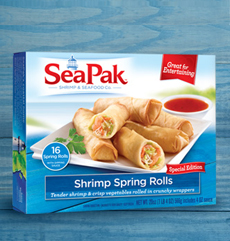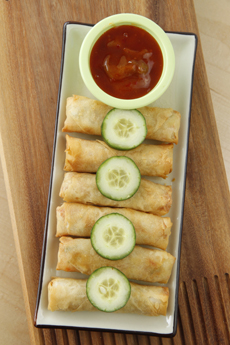PRODUCT: SeaPak Shrimp Spring Rolls
|
In 1948, SeaPak opened shop on St. Simons Island, Georgia, a beautiful barrier island. The waters were rich in shrimp, and the company went to work developing enjoyable products to bake, fry and sauté. Today SeaPak has a large lineup of tasty, easy-to-prepare frozen seafood products, from jumbo butterfly shrimp and popcorn shrimp to non-shrimp favorites such as crab cakes and salmon burgers (see the full product range on the company website). The newest item, SeaPak Spring Rolls, recently launched nationwide in grocery and club stores. Handmade with shrimp and crispy vegetables and tucked into crunchy wrappers, Shrimp Spring Rolls are simple to heat-and-eat in the oven, and are ready in less than 15 minutes. Or, for a more traditional restaurant taste, get out the deep fryer. Sweet Thai chili dipping sauce is included in each package. According to the package, three shrimp spring rolls—a nice portion size—contains only 170 calories and 9 grams of fat. |
SeaPak’s shrimp rolls are better than most we‘ve had at restaurants. Photo by Elvira Kalviste | THE NIBBLE. |
|
|
EASY TO PREPARE We preheated the oven, quickly baked up a box in THE NIBBLE kitchen and served them as a snack. The general comment was that SeaPak’s shrimp rolls were better than what is served at most Chinese restaurants. And that was without the added flavor of deep frying! Serve them as an appetizer or snack, and keep a box in the freezer for when friends drop by for a beer or a glass of wine. SUSTAINABLE SEAFOOD Fifty percent of the seafood is wild-caught rather than farmed. Why only 50%? Demand is so great that the oceans cannot satisfy even half of the consumer need. |
||
 Frozen and ready to bake or fry. Photo courtesy SeaPak. |
SHRIMP 101 SeaPak answers some commonly-asked questions and busts some myths: |
|
|
THE DIFFERENCE BETWEEN EGG ROLLS, SPRING ROLLS & SUMMER ROLLS While some countries, including China, serve fried spring rolls, the term “spring roll” is not synonymous with “egg roll,” a food that is fried. An egg roll has a heavier pastry wrapper that can be sliced into sections; a fried spring roll is very fragile and can shatter like phyllo.
|
||



